Wetsuit – a garment that protects the swimmer against hypothermia and injuries of the skin. The wetsuit is used for various types of water sports, including spearfishing, diving, freediving, Windsurfing, as well as for diving.
Choose a wetsuit with a mandatory fitting. It should fit exactly to the size and fit snugly to the body, like a second skin. Too bad free suit is warm, too close will be hard to breathe, leading to rapid fatigue of the swimmer.
You can use the following criteria:
- neck area-the suit should sit tight, but not pinch;
- armpits-small gaps are allowed;
- perineum-tight fit;
- lower back – loose-fitting with regard to the bend of the spine;
- ankles and wrists-tight fit (through them most often gets water).
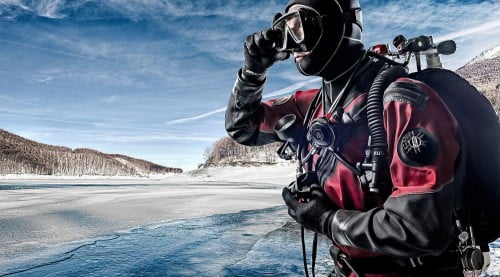
Tips for fitting your scuba diving suit:
- there should not be a bloated air bubble on the back, otherwise, the suit will get too much water and it will not be effective;
- to feel how comfortable the wetsuit is, you can lie on your stomach, bend your legs to your back and try to simulate swimming. At the same time, the movements should be free, and the suit itself should not crash into the body;
- it is recommended to measure the Shoe together with a thermal sock.
To minimize the penetration of water from the outside, obturators are used – special seals that ensure a tight fit of the suit to the body. They are placed on the edge of the hood, in the cuffs around the hands and ankles.
Important: some wetsuits, for example, without internal duplication, are put on with a special gel or talc. You can also use soap and shampoo for this purpose.
Scuba suit view
Wet - the most common type, passes a certain amount of water through the zipper and loose areas of the wetsuit.
This water, being heated to the swimmer’s body temperature, becomes a heat insulator and prevents the penetration of cold water from the outside.
Thus, a wet wetsuit on the principle of action reminiscent of the thermos. However, over time, the cold water still penetrates, and the swimmer loses heat.
Dry suit – does not pass water inside the wetsuit, which means that it preserves the heat generated by the body.
The tightness of the suit is achieved thanks to the obturators on the hands and neck, waterproof zippers, and sewn or glued special socks/shoes.
A dry wetsuit has valves that supply (blow) or pump (bleed) air from the suit. Due to the relatively large thickness of such equipment, the swimmer’s movements are restricted.
The price of a dry wetsuit is much higher than a wet one. Drysuit – the best option in case of prolonged stay in cold water (12°C and below) - diving or diving operations, as well as with little activity of the swimmer.
Semi-dry-intermediate option: like dry, it is equipped with seals and a sealed zipper, but it allows a little water (maximum 200-250 g). Retains heat better than wet.
It can often contain a sewn-in water helmet and an additional neoprene t-shirt. Thermal insulation is achieved due to the thickness of the neoprene and due to the water located between the wetsuit and the body.
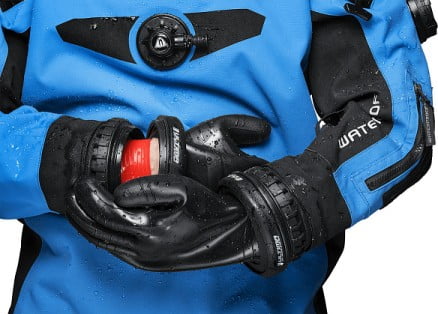
Wet suit material
The vast majority of wetsuits are made of waterproof material-neoprene (foam rubber).
It has two main parameters:
- compression resistance / recovery-the ability of neoprene to restore its thickness after the swimmer has surfaced: slows down the thinning of the neoprene, and therefore the deterioration of the thermal insulation of the suit;
- elasticity-allows the wetsuit to fit snugly around the body to avoid heat loss due to the water circulation inside it.
This material is found in several types:
- S\L-smooth (“rubber out”), most often has a dark color; it is a warm material, but sensitive to mechanical influences and UV rays, as a result of which such a suit quickly fails;
- D\L-consists of three layers (fabric+neoprene+fabric): this material is much stronger and less sensitive to UV rays; however, ” D\L “is colder than” S\L”; 3 mm thick neoprene” S\L “is equal to 4 mm” d\L ” neoprene in thermal properties.
It should be noted that there is a new modification of neoprene “D\L”, which is equal in heat to” S\L ” neoprene, but costs more.
There are also wetsuits made of a combined material “D/L-S/L” (chest, sleeves, back – “S/L”, the rest – “D/L”). Wetsuits for freediving and spearfishing are made of neoprene”open time”.
This neoprene is cut especially so that it sticks well to the skin with its “open” bubbles.
Dry wetsuits can be made of the following materials:
- trilaminate (rubber-nylon) - almost does not retain heat, so it is recommended to use it together with a thermal underwear;
- pressed neoprene-perfectly fits the body and warms in cold water, but this suit is quite massive, not too resistant to wear, when you go out in the cold quickly freezes, while it is expensive;
- crushed neoprene-similar in properties to the previous suit, but much more resistant to mechanical damage and compression underwater; the most durable material.
Diving suit thickness
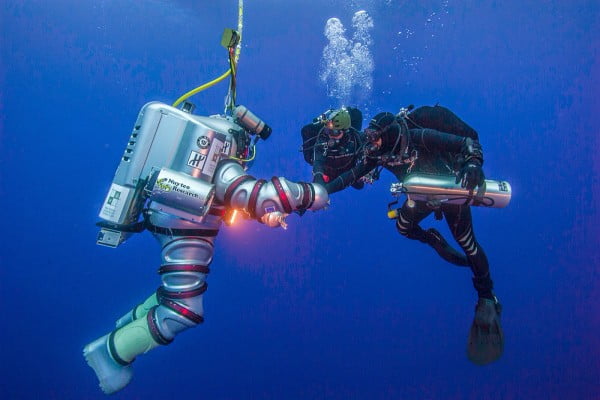
The thickness of the suit must be selected depending on the water temperature and time spent at depth. The lower the water temperature and the longer the time, the thicker the wetsuit should be. In warm water, most often use a suit with a thickness of 3-5 mm, in cold water – 7-11 mm.
The dependence of the thickness of the diving suit on the water temperature can be represented as this ratio:
- 30°C and above - 2 mm suit (wet);
- 25-30°C - 3 mm suit;
- 23-25°C - 3 mm+hood;
- 21-23°C - 3 mm+hood+vest or wetsuit 6 mm thick;
- 12-18°C - 6-7 mm;
- below 12°C - dry suit.
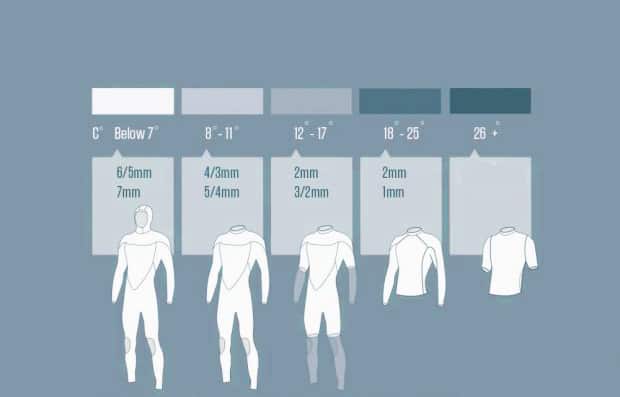
The greater the thickness of the wetsuit, the less its elasticity, so the thickness can be combined: under the knees, on the elbows, in the armpits, and other places associated with active movement, there are inserts of a material of a smaller thickness. In this case, specify the minimum and maximum thickness of the suit, for example, 2/3 mm or 3/4 mm.
Important: if necessary, the wetsuit can be supplemented with insulation, which is worn on top as a jacket. In this case, the thickness of the wetsuit increases. Sometimes this insulation has a built-in helmet.
Duplication
To increase the strength, thermal insulation qualities, as well as to improve putting on wet wetsuits, neoprene is often duplicated by the following materials:
- plush (PL), as a rule, duplicates the inner side of the suit, which greatly facilitates it’s putting on and taking off;
- nylon (N) duplicates both the inner and outer sides of the suit; with internal duplication, the wetsuit can be worn without the use of shampoo and gel, and with external-significantly increases the strength of the suit;
- stretch (XTend) increases the elasticity of the suit, which makes the dive more comfortable;
- titanium deposition (Ti) improves the thermal insulation of the suit due to the heat-reflecting properties of the metal. Single-sided spraying reduces heat loss by 20-25 %, double-sided-up to 30 %.
There are several types of wet suits:
Not duplicated (“naked”) - soft, thin, elastic, providing maximum freedom of movement of the swimmer. However, this wetsuit has low thermal insulation properties and is sensitive to the slightest damage – it is easily torn or punctured.
With one-way duplication-occurs in two varieties:
- duplicated from the inside - the wetsuit is easy to put on, but the fabric promotes water circulation, which leads to heat loss; the suit is sensitive to mechanical damage (vulnerable places-elbows, knees, head);
- duplicated from the outside (“sticky”) – much more sealed and stronger than the previous wetsuit, but difficult to put on (only using gel, soap, shampoo).
With two-way duplication-has the advantages of the previous two types. These suits are the most durable and reliable, but very rigid, which means that they restrict the freedom of movement of the swimmer underwater.
Combined-combines the qualities of various wetsuits. For example, a jacket or trousers made of rubber to the body, and in some areas have internal inserts of a duplicate material, which leads to water circulation on the skin.
Diving-the best option is a wet suit with double-sided duplication, having long sleeves, but without a helmet. For more severe conditions, you can wear a warming vest. You can use a dry suit. It is important that the costume was bright colors: the swimmer can better fit into the underwater world and not scare away its inhabitants.
Freediving - perfect wet “naked” suit that allows you to quickly and easily dive to a great depth, as well as move freely underwater. Due to insufficient thermal insulation properties of the suit, it is insulated with a coating of biothermal ceramics and titanium. Spraying allows you to wear a suit without gel, but increases the risk of its rupture.
Spearfishing – a good choice will be a wet one-way duplicated wetsuit with a special Kevlar insert to stop the gun when reloading. The outer layer of fabric protects the suit from mechanical influences, and a dark or spotted color well masks the hunter in the water environment.
Important: suits with double-sided duplication are not suitable for hunting, as they restrict the movement of the hunter, and during long swimming increases the loss of heat due to the circulation of water inside the suit.
Windsurfing-wet or semi-dry wetsuit (short arms/legs or short arms/long legs) is suitable. These models are usually rubberized at the knees for additional protection of the suit.
Important: in addition to the wetsuit, it is recommended to use neoprene socks, gloves, and gloves that protect against hypothermia, bites, and scratches. If you plan a long dive at a low temperature, then a good addition will be neoprene t-shirts.
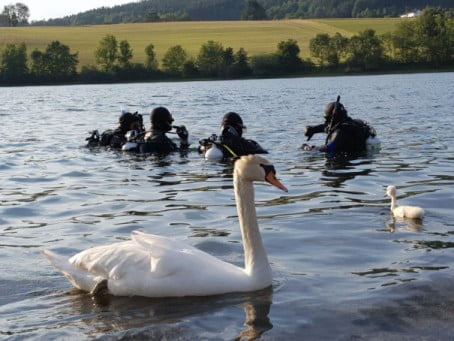
Dive suit design
- Short – short arms and legs (shorts). These suits are always wet.
- Suit with long legs and short arms / detachable sleeves-wet suit.
- Long – completely long arms and legs: both dry and wet suits.
- Monosuit-a jumpsuit, usually with a helmet, covering the entire body of the swimmer. It does not violate the natural stability (buoyancy) of a person in the water.
- Separate-jumpsuit with straps + jacket with helmet and sleeves. This suit is convenient to put on, warmer than a monosuit, because it consists of a double layer of neoprene.
- Combined – consists of several elements: a monosuit, jacket, and helmet. Various combinations of them allow you to choose the best suit for each occasion.
Lightning

The zipper makes it much easier to put on and take off the wetsuit, but water penetrates through it. Sometimes the zipper is equipped with a special flap to protect it from water ingress.
The lightning bolt can be located:
- on the chest - it is convenient to fasten and unbutton, but sometimes it may bulge; it is good if the zipper is equipped with a double slider – this will allow it to be fastened/undone from above and below;
- on the back - the wetsuit does not bulge when bending, but this zipper is inconvenient to fasten and unbutton;
- on the neck – the worst option, because it is in the zone of the greatest activity and causes great inconvenience.
The zipper on the chest should be fastened with a little effort. If it is difficult to fasten, then you should choose a suit a size larger, if it is too easy to fasten – then a size smaller.
Seams
The type of seams depends on the strength of the connection of the parts of the wetsuit, therefore, its durability and efficiency.
- Glue and tape - an economical, but not very durable type of seam.
- Zigzag seam - found in colored inserts on the neck, hood, and other places that have a small load.
- Seam Mauser - wide and strong seam without sizing. However, if the threads do not withstand the load, the seam will split.
- Blind seam – the most durable, reliable, and flexible seam – it is first glued, and then sewn in a special way.
Scuba diving suit care tips
You should wash the wetsuit in freshwater after diving, since salt crystals damage the rubber when it dries. Do not dry the suit in direct sunlight, or near heating devices.
When storing and transporting the suit, do not allow permanent folds, kinks, or stretches. In a dry suit, it is recommended to lubricate the sealed zipper with silicone grease before diving.
If the suit will not be used for a long time, then the blow-off and bleed valves should be thoroughly washed with clean water.
Manufacturer
Among diving and spearfishing enthusiasts, the most reputable brands are Aqua Lung, Bare, Beuchat, Cressi, Mares, and SeacSub.
Each of them guarantees the quality of their products: the best neoprene, tailoring, fit of the suit, that is, its anatomical features.
In all brands, you can find both budget models for novice divers, and wetsuits for professional athletes or hunters.
How to choose a diving suit/ deep sea diving suit?
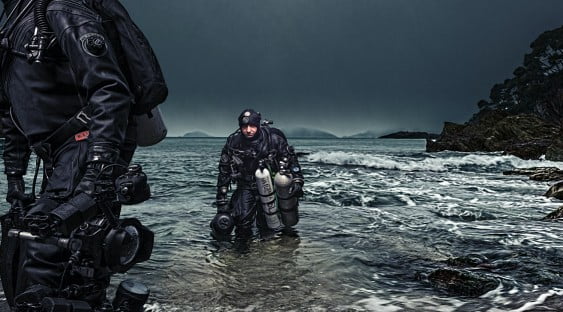
For professional diving, dry Hydra is used, since it is more difficult to control buoyancy in such a suit, you need to learn. Amateur divers can choose a wet monosuit.
And depending on the temperature of the water where the dives will be, choose the thickness of the material 3-5-7 mm.
However, it is worth remembering that everyone has different heat exchange, there are no identical people, and the data on comfortable temperature is averaged.
It is known that women, thin people, and the elderly cool down faster. Plus, you also need to take into account the depth of the dive-the pressure will affect the neoprene, it will lose its thermal insulation properties.
When marking a wetsuit, manufacturers specify 2 digits: for example, 3/2. This means that the clothing is combined with 3 and 2 mm thick neoprene.
Thanks to this, elasticity is achieved in the right places, and the best fit is achieved. You will also see the letters on the Hydra-D/L and S / L (double-lined and single lined), that is, double - neoprene is glued with nylon on both sides, and single - on one.
You will be warmer in an S/L suit, but this Hydra will last less than a D/L suit.
And before you buy a particular atmospheric diving suit, you need to try on several options from several brands.
Since everyone’s bodies are different, the size grids of different brands may also differ. And which wetsuit fits you better can only be understood empirically: by trying on several different ones.
A good hydric should sit like a cast, without folds, but not pull down to “woodiness”. In any case, over time, the Hydra will stretch, so a tight fit is very important.
